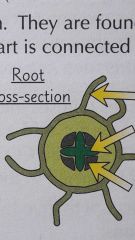![]()
![]()
![]()
Use LEFT and RIGHT arrow keys to navigate between flashcards;
Use UP and DOWN arrow keys to flip the card;
H to show hint;
A reads text to speech;
27 Cards in this Set
- Front
- Back
|
What substances do plants need to live? |
Water Minerals Sugars CO2 |
|
|
What kind of organisms are plants? What does this tell us about their surface area? |
Multicellular Small surface area to volume ratio |
|
|
Why aren't substances that the plants need exchanged by directs diffusion? |
The process would be too slow to meet their metabolic needs The distance in multicellular organisms is just too great SA: V ratio is too small |
|
|
What is therefore needed by plants to move substances from cell to cell quickly? |
Transport system |
|
|
What are the two types of tissues involved in transport in plants? |
Xylem and Phloem |
|
|
What do xylem tissues do? |
Transports water and mineral ions in solution. These substances move up the plant from the roots to the leaves. They also support the plant |
|
|
What do phloem tissues do? |
Transport mainly sugars solutes up and down the plant |
|
|
What system apart from the transport system do Xylem and Phloem make up? Why? |
Vascular system; they are found through out the plant and transport material to all parts. |
|
|
Where are Xylem and Phloem tissues found in the different parts of a plant |
Root: xylem is in the centre, phloem surrounds the xylem; they provide support for the roots as they push through soil. Stem: Near the outside to prevent scaffolding Leaf: make up network of veins which support the thin leaves |
|
|
How can you see the structure of the xylem and Phloem tissues? |
By taking transverse (perpendicular) and longitudinal (parallel) cross sections. |
|

Label the different parts: |
Root hair Xylem Phloem |
|
|
Where is the xylem always found compared to the phloem? |
The inside |
|
|
What part of the xylem tissues actually transport water and ions? |
Xylem vessles |
|
|
How are Xylem vessels adapted for their function? What does each feature do? |
* No end walls, allows flow of water *Cells are dead; so no organelles- more space for water * Have thick lignin walls: adds support and stops them from collapsing inwards |
|
|
What forms are lignin in? What happens as the plant gets older? |
*Spiral, Rings *lignin increases |
|
|
Where is there no lignin? Why? |
In the small pits along the xylem vessels, this is so water and ions can move into and out of the vessels |
|
|
What are phloem tissues purely used for? |
Transport of substances, not for support unlike xylem |
|
|
What does a phloem tissues contain? |
Sieve tube elements Companion cells |
|
|
What are seive tube elements? What is their function? |
*living cells *joined end to end to form seive tubes *seives are end walls which have holes to allow solutes through
|
|
|
What do the seive tube elements not have? |
Nucleus, almost no organelles and very thin layer of cytoplasm |
|
|
How are seive tube elements connected to other cells |
The the cytoplasm of adjacent cells connects through the holes in the seive plates |
|
|
What is needed for the survival of phloem seive tube elements? |
A companion cell |
|
|
Why is a companion cell needed? |
The seive tube elements do not have a nucleus and many other organelles so they cannot survive on their own. Each seive cell has a companion cell |
|
|
What is the function of companion cells? |
They cart out living functions for both themselves and the seive cells |
|
|
Quick method for a plant stem dissection: |
1) Cut thin cross sections (better for viewing under a microscope) 2) Place the cross sections in water till you need to use them to stop them from drying out. 3) Stain them with TBO; this stains the lignin blue-green (1min). This let's us see the position of xylem vessels and their structure 4)Rinse and mount on slide.
|
|
|
Where else can transpiration take place apart from the stomata in leaves? |
Epidermis |
|
|
What do lignin walls do? |
Stop xylem from collapsing inwards Support the plant |

